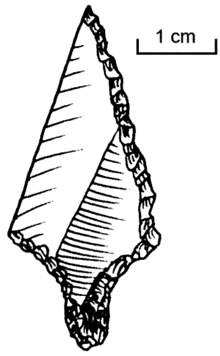Stem tip
Stem tips are characteristic stone artefacts from the late Upper Paleolithic that served as arrowheads . The tips made of flint are the leading form of several late Ice Age archaeological cultures in northern Central Europe:
- of the Ahrensburg culture ,
- the Danish bromme culture ,
- the Swedish Fosna culture ,
- of the Norwegian Komsa culture
- and the eastern Swideria .
Several complete arrows have come down to us from the Stellmoor site near Hamburg, the tips of which were attached to arrow shafts made of pine wood.
Handle tips were made from tee-offs . As a functional precursor of the arrow reinforcement can cusps of Hamburg's cultural and penknives of Federmesser culture are considered.
In a broader sense, Font-Rôbert tips of the Gravettien are already referred to as stem tips. However, these were larger than the late glacial shapes and probably designed not as bow arrows, but as projectiles for spears . It is possible that spears equipped with Font-Rôbert points were already thrown with the spear thrower, although this weapon is only archaeologically documented from the late Solutréen onwards. The Font-Rôbert point has a broad leaf, retouched on both sides, with a long, symmetrical central stem.
The stem tips of the North African Atérien are an independent group . In contrast to the European tips, these are almost exclusively processed on one side, while the handle mostly received a complete retouch. Presumably they were used as spearheads.
Individual evidence
- ↑ Wolfgang Taute : The stem tip groups in northern Central Europe: a contribution to the knowledge of the later Paleolithic. Böhlau Cologne 1968
